The Dinosaur Family Tree: Where Do Chickens Fit In?
Dinosaurs ruled the Earth for over 165 million years, and they came in all shapes and sizes. They are divided into two main groups: the saurischians (“lizard-hipped”) and the ornithischians (“bird-hipped”). Ironically, it’s from the “lizard-hipped” branch—specifically a subgroup called theropods—that birds evolved.
Theropods were mostly carnivorous dinosaurs that walked on two legs. Famous examples include Velociraptor and T. rex. Fossil evidence shows that some of these theropods began to develop bird-like features, such as:
- Hollow bones
- Feathers
- Three-toed limbs
- Wishbones (furcula)
- Nesting behavior
Over millions of years, these features became more pronounced, and eventually, a lineage of small, feathered theropods gave rise to the very first birds.
Archaeopteryx: The First Bird
One of the most important fossil discoveries in evolutionary biology is Archaeopteryx, a creature that lived about 150 million years ago. It had wings and feathers like a bird, but also teeth, a long bony tail, and clawed fingers—traits associated with reptiles and dinosaurs.
Archaeopteryx represents a transitional species between non-avian dinosaurs and modern birds, giving scientists clear proof that birds evolved from dinosaurs.
Evolution Through Time: From Raptors to Roosters
Scientists have identified many species of feathered dinosaurs that lived during the late Jurassic and Cretaceous periods. These species bridge the evolutionary gap between non-avian dinosaurs and birds. Some, like Microraptor, had feathered wings not only on their arms but also on their legs, possibly enabling them to glide through trees.
Eventually, these flying dinosaurs diversified into many bird-like forms, adapting to different environments. After the mass extinction event 66 million years ago—likely caused by a massive asteroid—most dinosaurs went extinct. However, some bird-like dinosaurs survived and continued to evolve.
One lineage of these survivors eventually gave rise to all modern birds, including sparrows, eagles, and yes, chickens.
What Makes Chickens Dinosaur Descendants?
Chickens (Gallus gallus domesticus) share several anatomical and genetic traits with their dinosaur ancestors:
- Skeleton: The structure of a chicken’s leg bones, wishbone, and skull closely resembles that of certain theropods.
- Feathers: Feathers originally evolved for insulation and display in dinosaurs, not for flight. Chickens, although flightless, still retain these feather structures.
- Eggs: Dinosaurs laid eggs, just like chickens do. Even the texture and structure of fossilized dinosaur eggs resemble those of modern bird eggs.
- Behavior: Nesting, vocalizing, and even social behavior seen in chickens can be traced back to their dinosaur relatives.
In 2006, researchers managed to extract proteins from a well-preserved T. rex bone. When compared to the proteins in modern animals, the closest match was found in—believe it or not—chickens. This molecular evidence strongly supports the theory that birds are the modern descendants of dinosaurs.
Reverse Evolution: Can Chickens Become Dinosaurs Again?
In a twist worthy of science fiction, some scientists are attempting to reverse-engineer chickens to exhibit ancestral dinosaur traits. One such experiment is called the “Chickenosaurus” project. Researchers are studying chicken embryos to “turn on” ancient genes that have been switched off over millions of years.
For example:
- Scientists have succeeded in giving chicken embryos snouts instead of beaks.
- Others have tried to reintroduce long tails, teeth, and clawed fingers.







Leave a Reply